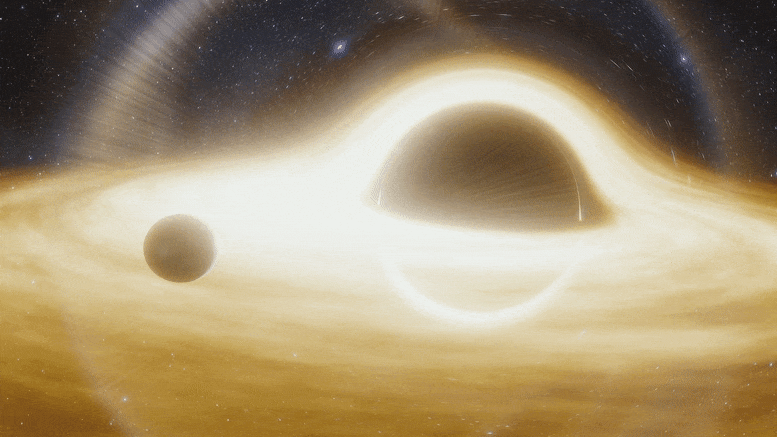
Scientists have long believed that supermassive black holes can wander through space – but it is difficult to catch them.
Now researchers from the Center for Astrophysics | Harvard and Smithsonian have identified the clearest case to date of a supermassive black hole in motion. Their results will be announced today (12 March 2021) in The Astrophysical Journal.
‘We do not expect most supermassive black holes to move; they are usually content to just sit around, ”says Dominic Pesce, an astronomer at the Center for Astrophysics who led the study. “They are just so heavy that it’s hard to get them going. Think of how much harder it is to kick a bowling ball in motion than to kick a football while realizing that the ‘rolling ball’ is several million times the mass of our sun. It’s going to take quite a powerful kick. ”
Pesce and his associates have been working for the past five years to observe this rare occurrence by comparing the velocities of supermassive black holes and galaxies.
“We asked: are the velocities of the black holes the same as the velocities of the galaxies in which they live?” he explains. ‘We expect them to have the same speed. If they do not, it means the black hole is disturbed. ”

It is suspected that Galaxy J0437 + 2456 is home to a supermassive, moving black hole. Credit: Sloan Digital Sky Survey (SDSS)
For their search, the team initially explored ten galaxies in the distance and the supermassive black holes at their core. They specifically studied black holes that contain water in their growth disks – the spiral structures that turn inward toward the black hole.
As the water revolves around the black hole, it produces a laser-like ray of radiolight known as a maser. When studied with a combined network of radio antennas using a technique known as very long base interferometry (VLBI), masers can help to measure the velocity of a black hole very accurately, says Pesce.
The technique helped the team determine that nine of the ten supermassive black holes were at rest – but one was conspicuous and appeared to be in motion.
The black hole is located 230 million light-years from Earth and is in the center of a galaxy called J0437 + 2456. Its mass is about three million times that of our Sun.
Using follow-up observations with the Arecibo and Gemini Observatories, the team has now confirmed their initial findings. The supermassive black hole moves at a speed of about 110,000 miles per hour within the J0437 + 2456 galaxy.
But what caused the motion is not known. The team suspects there are two possibilities.
“We could merge the effects of two supermassive black holes,” said Jim Condon, a radio astronomer at the National Radio Astronomy Observatory who was involved in the study. “The result of such a merger could cause the newborn black hole to recede, and we could watch it retreat or recede.”
But there is another, perhaps even more exciting possibility: the black hole could be part of a binary system.
“Despite every expectation that they really should be there to a large extent, scientists have had a hard time identifying clear examples of binary supermassive black holes,” says Pesce. “What we could see in galaxy J0437 + 2456 is one of the black holes in such a pair, while the other remains hidden from our radio observations due to the lack of emission of machine.”
However, further observations are ultimately needed to determine the true cause of the unusual movement of this supermassive black hole.
Reference: “A Restless Supermassive Black Hole in the Galaxy J0437 + 2456” by Dominic W. Pesce, Anil C. Seth, Jenny E. Greene, James A. Braatz, James J. Condon, Brian R. Kent and Davor Krajnović, 12 March 2021, The Astrophysical Journal.
DOI: 10.3847 / 1538-4357 / abde3d
Co-authors of the new study are Anil Seth of the University of Utah; Jenny Greene van Princeton University; Jim Braatz, Jim Condon and Brian Kent of the National Radio Astronomy Observatory; and Davor Krajnović of the Leibniz Institute of Astrophysics in Potsdam, Germany.
